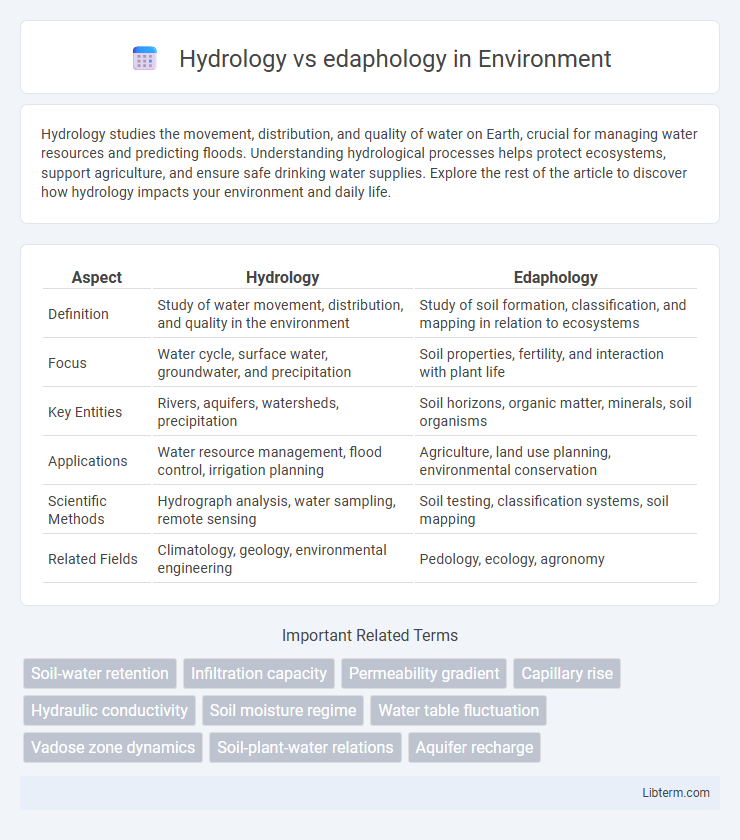Hydrology studies the movement, distribution, and quality of water on Earth, crucial for managing water resources and predicting floods. Understanding hydrological processes helps protect ecosystems, support agriculture, and ensure safe drinking water supplies. Explore the rest of the article to discover how hydrology impacts your environment and daily life.
Table of Comparison
| Aspect | Hydrology | Edaphology |
|---|---|---|
| Definition | Study of water movement, distribution, and quality in the environment | Study of soil formation, classification, and mapping in relation to ecosystems |
| Focus | Water cycle, surface water, groundwater, and precipitation | Soil properties, fertility, and interaction with plant life |
| Key Entities | Rivers, aquifers, watersheds, precipitation | Soil horizons, organic matter, minerals, soil organisms |
| Applications | Water resource management, flood control, irrigation planning | Agriculture, land use planning, environmental conservation |
| Scientific Methods | Hydrograph analysis, water sampling, remote sensing | Soil testing, classification systems, soil mapping |
| Related Fields | Climatology, geology, environmental engineering | Pedology, ecology, agronomy |
Introduction to Hydrology and Edaphology
Hydrology studies the distribution, movement, and quality of water on Earth, emphasizing the water cycle, surface water, and groundwater dynamics. Edaphology focuses on soil properties, formation, and its influence on plant growth, considering factors like soil structure, texture, and nutrient availability. Understanding hydrology aids in water resource management, while edaphology is crucial for agricultural productivity and ecosystem health.
Defining Hydrology: Scope and Importance
Hydrology is the scientific study of the movement, distribution, and quality of water throughout the Earth, encompassing the water cycle, precipitation, runoff, infiltration, and groundwater flow. It plays a crucial role in managing water resources, predicting floods, and understanding climate impacts on water systems. Unlike edaphology, which focuses on soil properties and their influence on plant growth, hydrology addresses the broader dynamics of water in natural and engineered environments.
Edaphology Explained: The Science of Soils
Edaphology, a branch of soil science, focuses on the influence of soils on living organisms, especially plants, by studying soil properties, formation, and classification to improve agricultural productivity and environmental management. Hydrology examines the distribution, movement, and quality of water within the Earth's atmosphere and soil, emphasizing the hydrological cycle and water resources. Understanding edaphology is essential for soil fertility analysis, crop management, and sustainable land use, distinguishing it from hydrology's broader water-centric approach.
Key Differences Between Hydrology and Edaphology
Hydrology studies the distribution, movement, and quality of water on Earth, emphasizing water cycles, surface water, and groundwater interactions. Edaphology focuses on soil science, specifically soil formation, classification, and its influence on plant growth and ecosystems. Key differences include hydrology's concentration on water processes versus edaphology's emphasis on soil properties and their impact on flora and land use.
The Interconnection of Soil and Water Studies
Hydrology and edaphology are interconnected fields that study water and soil interactions critical for understanding ecosystem dynamics and agricultural productivity. Hydrology focuses on the movement, distribution, and quality of water in the environment, while edaphology examines soil properties, formation, and its influence on plant growth. The integration of these disciplines enhances soil moisture conservation, groundwater recharge assessment, and sustainable land management practices.
Methodologies Used in Hydrology vs. Edaphology
Hydrology employs methodologies such as remote sensing, streamflow gauging, precipitation measurement, and watershed modeling to analyze water movement, distribution, and quality. Edaphology utilizes soil sampling, laboratory analysis for physical and chemical properties, soil profile description, and moisture retention tests to study soil characteristics and their influence on plant growth. Both disciplines integrate Geographic Information Systems (GIS) for spatial analysis but focus on distinct environmental variables.
Applications in Environmental Science and Agriculture
Hydrology primarily studies the movement, distribution, and quality of water, crucial for managing water resources, predicting floods, and supporting irrigation systems in agriculture. Edaphology focuses on soil properties, formation, and fertility, essential for optimizing crop production, soil conservation, and assessing contamination risks in environmental science. Both disciplines intersect to enhance sustainable land use practices, improve ecosystem services, and support climate resilience strategies in agricultural and environmental planning.
Impacts on Ecosystem Management
Hydrology impacts ecosystem management by regulating water availability, influencing soil moisture patterns, and controlling nutrient transport critical for vegetation growth and habitat health. Edaphology studies soil properties and processes, directly affecting soil fertility, plant productivity, and microbial activity, which are essential for sustainable land use and restoration practices. Integrating hydrological and edaphological data enhances ecosystem resilience, informs water-soil-plant interactions, and optimizes conservation strategies under changing climatic conditions.
Career Paths in Hydrology and Edaphology
Hydrology careers focus on water resources management, environmental consulting, and hydrological research, emphasizing groundwater modeling, watershed analysis, and flood risk assessment. Edaphology careers revolve around soil science, agricultural optimization, and land use planning, specializing in soil fertility, erosion control, and nutrient cycling. Both fields offer roles in government agencies, environmental organizations, and academic research, but hydrology aligns more with water cycle studies while edaphology centers on soil-plant interactions.
Future Trends in Soil and Water Research
Future trends in soil and water research emphasize the integration of hydrology and edaphology to enhance sustainable land management practices. Advanced remote sensing technologies and machine learning models are being developed to analyze soil moisture dynamics and nutrient cycles more accurately, facilitating precision agriculture and climate resilience. Increased interdisciplinary studies aim to optimize water use efficiency and soil health, addressing challenges posed by climate change and population growth.
Hydrology Infographic

 libterm.com
libterm.com